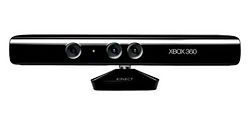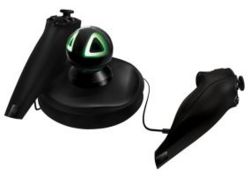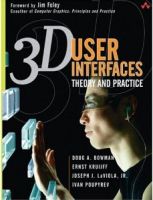Difference between revisions of "CSE190W2013"
(→Paper Presentation) |
(→Paper Presentation) |
||
| Line 74: | Line 74: | ||
* The presenter's comprehension of the paper | * The presenter's comprehension of the paper | ||
| − | * The | + | * The quality of the presentation |
* The quality of the slides | * The quality of the slides | ||
Revision as of 21:29, 29 January 2013
Contents |
CSE190: 3D User Interaction

|
DescriptionThis course focuses on the design and evaluation of three-dimensional (3D) user interfaces, devices, and interaction techniques. The course consists primarily of lectures and hands-on programming. Students will be expected to implement several 3D interaction techniques as part of this course. This course is intended to lay the foundation for 3D user interaction as it can be applied to novel user interfaces for computer games and consumer electronics, as well as virtual and augmented reality applications. An important aspect of the course are going to be programming assignments involving 3D interaction devices, which are going to be provided to the students in the computer lab. These devices will include the Microsoft Kinect, which allows gesture control, and the Razer Hydra, which allows high-precision 3D interactions. We will use the C++ programming language and the OpenGL API. Click here for the course schedule. |

|

|
| Microsoft Kinect | Razer Hydra |
Announcements
- 2013-01-27: Homework assignment 2 is now on-line
- 2013-01-24: Homework grading for assignment 1 will happen in Sequoyah lab 142 tomorrow, Friday, starting at 12:30pm. The homework is due at 1pm so everyone should be there by that time.
- 2013-01-24: Sid Vijay is now officially the TA for this course. Welcome!
- 2013-01-21: The z-fighting problem with the 3D models for the first homework assignment has been resolved. Just use the newly uploaded .zip files instead of the old ones.
- 2013-01-16: OpenSceneGraph build instructions now on this web site, scroll down to Resources
- 2013-01-13: Homework assignment 1 is now on-line
Topics
- Introduction to 3D interaction
- Application domains
- Output hardware
- Input hardware
- Selection and Manipulation
- Navigation (Travel and Wayfinding)
- System Control
- Symbolic Input
- 3D user interface design
- Evaluation of 3D User Interfaces
- Augmented Reality Interfaces
Prerequisites
- CSE167 (Introduction to Computer Graphics) or equivalent
- Experience programming in C++
- Experience with OpenGL graphics programming
Format
- Instructor: Jürgen Schulze
- Instructor's office hour: Mondays 2-3pm, Atkinson Hall, room 2125
- Number of Units: 4
- Lectures: Monday and Wednesday, 11:00am-12:20pm in EBU-3B, room 2154
- First lecture: Monday, January 7th, 2013 ***Update: cancelled; first lecture on Wednesday, January 9th***
- Last lecture: Wednesday, March 13th, 2013
- Homework: programming assignments
- Paper presentation (see below for details)
- Designated computer lab for this course: Sequoyah Hall room 142
- TA: Sid Vijay, office hours in lab Sequoyah Hall 142: Tue/Thu 11am-1:30pm
Paper Presentation
Each student must give a 12 minute presentation (+ 3 min. Q&A) of a paper of their choice from the field of 3D user interfaces.
It is required that the presentation be accompanied by a slide presentation. The slide presentation can be done on your own laptop with a VGA output, or it can be emailed or given to the instructor on a USB thumb drive (Powerpoint or PDF format only).
Each presenter will be graded on the following criteria:
- The presenter's comprehension of the paper
- The quality of the presentation
- The quality of the slides
Here are some general questions to help guide you when presenting a paper to the class.
- What did the author(s) study? What issue about this topic were the author(s) trying to better understand?
- Why do we care about this topic?
- What methods did the author(s) use? Why are these methods suited to better understand the problem at hand?
- What are the main conclusions from this work?
Here are some general guidelines as to how to generate group discussion.
- What part of the work was confusing to you?
- What parts were well explained and what parts were poorly explained?
- What type of previous studies is this work building on?
- What is the next step after this work?
- Are there other implications of this work that the authors haven’t considered?
Grading
| Assignment 1 (group) | 15% |
| Assignment 2 (group) | 15% |
| Assignment 3 (group) | 15% |
| Assignment 4 (group) | 15% |
| Paper Presentation (individual) | 15% |
| Final Exam (individual) | 25% |
You will find your scores on Ted. Please verify after every due date that your score has been recorded correctly.
If your weighted average score across all assignments is 100 points or more, you will get a grade of A+.
Textbook

|
Bowman, Kruijff, LaViola, Poupyrev 3D User Interfaces: Theory and Practice Addison Wesley Longman Publishing Co., Inc. Redwood City, CA, USA 2004 ISBN: 0201758679 |
Homework Assignments
All homework assignments are due at 1pm on the due date and have to be demonstrated to the instructor or TA/tutor in lab SEQ 142.
- Homework Assignment #1: OpenSceneGraph. Due Friday, Jan 25th at 1pm in SEQ142
- Homework Assignment #2: ARToolkit. Due Friday, Feb 8th
- Homework Assignment #3: Due Friday, Feb 22nd
- Homework Assignment #4: Due Friday, Mar 8th